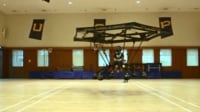Researchers at Johns Hopkins University are studying spider crickets' jumps, hoping to one day use their design principles to create small robots to maneuver across rough terrain like earthquake rubble.
Crickets can leap up to 60 times their body length… and Rajat Mittal wants to know how they do it.
Rajat Mittal, Professor of Mechanical Engineering at Johns Hopkins University, saying:
"The cricket is a marvel of, kind of engineering design. And we'd like to understand all those features that make this cricket do what it's able to do."
Mittal is a professor of Mechanical Engineering at Johns Hopkins University.
He says a better understanding of cricket mechanics could, one day, lead to the development of small robots designed to assist in search and recovery missions after natural disasters, like earthquakes.
Mittal and research assistant Emily Palmer recorded the insects at speeds of around 400 frames per second, so they could analyse their movements in slow motion.
Emily Palmer, Undergraduate research assistant, saying:
"So for every good jump we have, we like to track the position of the center of mass which is pretty much the cricket's stomach, their head and their tail for the entire jump."
Software called Matlab helped track the crickets' leaps and landings.
Rajat Mittal, Professor of Mechanical Engineering at Johns Hopkins University, saying:
"As they, when they start their jump they are nice and streamlined but then immediately after that they go into a mode where they fling their limbs out. And they start to try to balance themselves in the air and try to affect the rotation in the air and kind of keep themselves stable."
Mittal says, like ballerinas, the crickets land in a stable and controlled manner.
Harnessing that kind of locomotion, he says, could be a game-changer for robot mechanics.
Rajat Mittal, Professor of Mechanical Engineering at Johns Hopkins University, saying:
"For example, the aftermath of an earthquake where you have all kinds of rubble. Imagine crawling through all this rubble would take so much time, whereas jumping and leaping over rubble and things like that, to search for survivors, jumping would be a very effective way of exploring this very complicated terrain."
Mittal says that after six to eight more months of research, his team will have enough data to begin the next stage.
They want to work with a roboticist to harness some of the principles they have found - potentially using the secrets of the humble cricket to create a life-saving machine.



